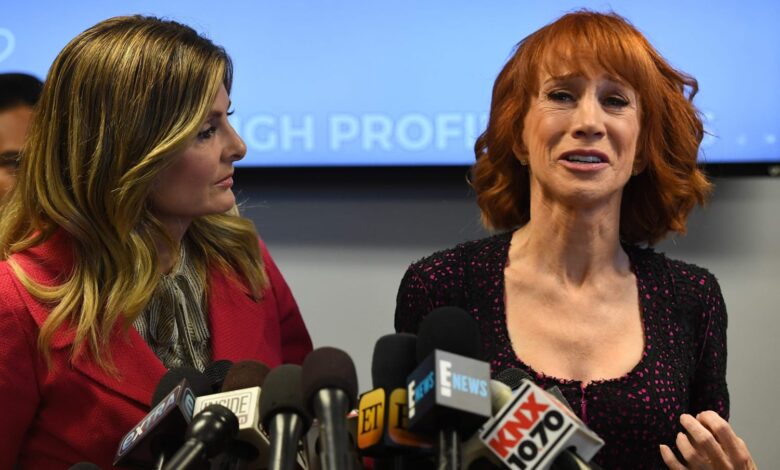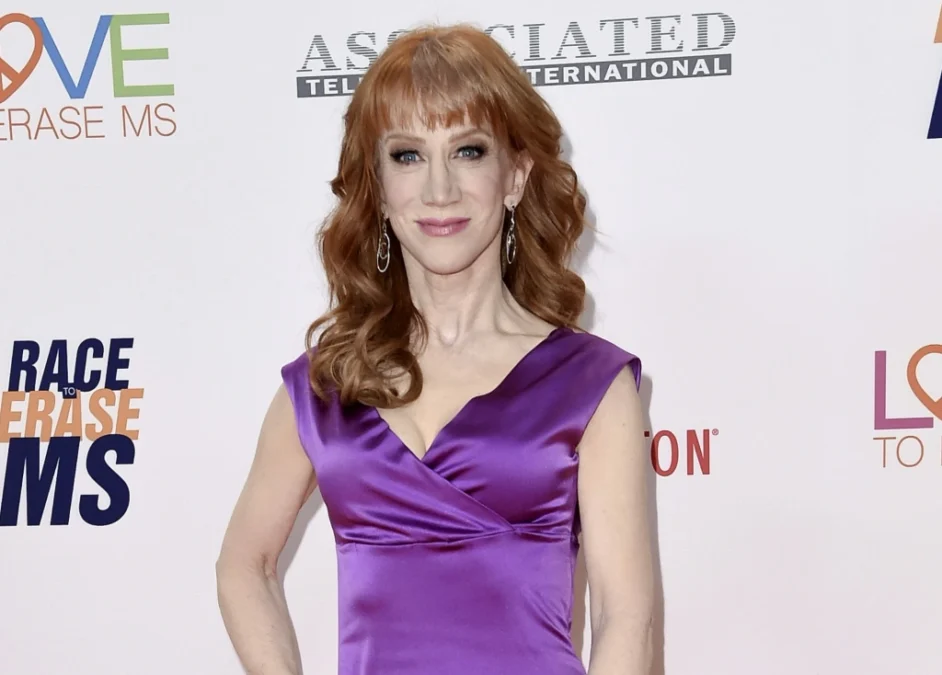
Kathy Griffin Trump Head: The Controversy That Shook Pop Culture
Kathy Griffin Trump Head The phrase “Kathy Griffin Trump head” ignited a media firestorm, divided public opinion, and forever changed the trajectory of the comedian’s career. This moment, etched into American pop culture history, wasn’t just about an image it was about the intersection of comedy, politics, and freedom of speech. What started as a provocative piece of performance art rapidly became one of the most polarizing moments in entertainment and political discourse.
Kathy Griffin, a veteran in the world of comedy known for her sharp wit and brash humor, found herself at the epicenter of backlash when a photo was released of her holding what looked like the severed, bloody head of then-President Donald Trump. The reaction was immediate, intense, and far-reaching. For some, it was a bold statement. For others, it was disturbing and offensive. Regardless of which side people took, one thing was certain the “Kathy Griffin Trump head” image had entered the national conversation and wasn’t going away anytime soon.
The Photo That Started It All
It began with a photo shoot intended to be edgy and satirical. Kathy Griffin teamed up with photographer Tyler Shields, known for his provocative imagery, to create a visual that would shock, awe, or at the very least, grab attention. And grab the attention it did.
The image of Kathy Griffin holding what appeared to be a severed, bloodied head resembling Donald Trump exploded across social media platforms almost instantly. Within hours, the image had been shared, re-shared, and dissected by pundits, celebrities, political figures, and everyday Americans. Griffin claimed it was intended as a mockery of Trump’s controversial policies and statements, framing it as political satire. But many, including people from both ends of the political spectrum, viewed it as crossing a line.
Backlash and Fallout
The response to the “Kathy Griffin Trump head” photo was swift and harsh. Mainstream news outlets began covering the controversy relentlessly. CNN dropped Kathy Griffin from its annual New Year’s Eve broadcast, which she had co-hosted for years. Sponsors pulled out, venues canceled shows, and friends in the industry distanced themselves.
Kathy Griffin found herself publicly shunned in ways she hadn’t anticipated. While she had always been considered an edgy comic, this particular act didn’t land as intended. It wasn’t just the public; even the Secret Service got involved, launching an investigation to assess whether the image posed a genuine threat to the President. Griffin later recounted feeling terrified during that period, unsure if she might face criminal charges.
Griffin’s Apology and Regret
In the days following the release of the “Kathy Griffin Trump head” photo, the comedian issued a tearful apology. Standing in front of cameras, Griffin expressed remorse for going too far. She stated that she understood how the image could be interpreted as threatening and said she “crossed the line.”
This apology, however, didn’t repair the damage entirely. While some appreciated her acknowledgment of the offense, others believed it was too late. Trump himself tweeted about the incident, claiming the image traumatized his family. His son, Barron Trump, was reportedly disturbed by the photo. The human aspect of the backlash especially regarding the impact on Trump’s youngest child struck a nerve with many people.
Free Speech Versus Social Boundaries
One of the core issues the “Kathy Griffin Trump head” controversy ignited was the tension between free speech and societal responsibility. In the United States, freedom of speech is protected under the First Amendment. However, the public has its ways of expressing disapproval, often in the form of backlash, boycotts, and social ostracization.
Kathy Griffin’s defenders argued that her actions, though shocking, fell under the category of political satire. They pointed to a long history of artistic depictions of political figures in controversial and grotesque ways. Detractors, however, argued that the image incited violence and was in poor taste, especially in an already polarized climate. The “Kathy Griffin Trump head” image wasn’t just a photo it was a litmus test for how far artists and entertainers could go in the Trump era.
A Career Turned Upside Down
The ramifications of the scandal extended far beyond a few canceled gigs. Kathy Griffin’s entire career trajectory shifted. She found herself blacklisted from major networks, unable to book shows in traditional venues, and cut off from longtime friends and collaborators.
The “Kathy Griffin Trump head” episode marked a turning point in her life. Griffin has often stated that she faced extreme consequences for what she believes was a form of political expression. In later interviews, she claimed that the industry’s reaction revealed an undercurrent of fear and conformity, especially when it came to criticizing powerful figures. Whether that’s accurate or not, it’s undeniable that she experienced a kind of professional exile rarely seen in modern entertainment.
Reinvention and Comeback
Despite the intense backlash, Kathy Griffin didn’t disappear entirely. She used her experience as fuel for a new chapter in her career. Launching her “Laugh Your Head Off” tour, Griffin spoke candidly about the scandal, her experiences with the Secret Service, and her time in the wilderness of public disapproval.
The tour sold out in several cities around the world. Fans came not just for comedy, but for a story one about resilience, censorship, and survival. Kathy Griffin used the “Kathy Griffin Trump head” moment to shape a new narrative. She doubled down on her identity as an unapologetic provocateur and drew strength from those who believed her punishment was disproportionate.
The Role of Social Media in Amplifying the Crisis
It’s impossible to examine the “Kathy Griffin Trump head” moment without discussing the role of social media. The image went viral within minutes, showing how quickly public opinion can be swayed in the digital age. Twitter, Facebook, and Instagram became battlegrounds of opinion, with hashtags trending and memes circulating the clock.
In previous decades, such an image might have been shared among niche circles or art communities. But thanks to the rapid-fire nature of today’s platforms, Griffin’s photo was thrust into the global spotlight almost instantly. The virality intensified the scrutiny and created an avalanche of reactions that no PR team could contain.
The Gendered Nature of the Backlash
An often-overlooked aspect of the “Kathy Griffin Trump head” debacle is the gender dynamic at play. Griffin herself pointed out that male comedians and artists had made similarly violent or provocative statements about presidents without facing the same level of backlash.
This raised questions about whether Griffin was punished more severely because she was a woman in a male-dominated comedy world. Critics of this view argue that the image was simply too graphic and went too far, gender notwithstanding. Still, it’s worth analyzing how gender may have influenced the public and industry response.
A Divided America Reacts
The reactions to the “Kathy Griffin Trump head” photo mirrored the broader political division in America. Trump supporters saw the image as emblematic of Hollywood’s disdain for conservative values. Progressives were split some thought the stunt was brave, others thought it was counterproductive and unnecessarily inflammatory.
The incident highlighted the widening cultural chasm in American society. Even within liberal circles, debates raged about the boundaries of political protest. Was Griffin a martyr of free speech or a cautionary tale about the risks of provocation?

Comedy in the Age of Outrage
The comedy landscape has always pushed boundaries, but the “Kathy Griffin Trump head” photo raised the stakes. What’s acceptable in comedy has always been subjective, but this moment showed how quickly a joke or visual metaphor can become a national scandal.
For comics, Griffin’s story served as both inspiration and warning. It forced performers to question whether the price of boundary-pushing was worth paying. Griffin herself often remarked that she never expected the response to be as dramatic as it was suggesting even seasoned entertainers can misjudge public sentiment.
The Media’s Role in Shaping the Narrative
The media played a critical role in fanning the flames of the “Kathy Griffin Trump head” controversy. News outlets across the political spectrum latched onto the story, spinning it to fit their agendas. For conservative media, it was proof of Hollywood’s contempt for middle America. For liberal outlets, it was a tragic example of the price artists pay for political expression.
The sheer volume of coverage transformed a single image into a multi-week news cycle. Panel discussions, op-eds, cable debates, and blog posts dissected every angle. Griffin became a symbol, whether she liked it or not.
The Lasting Impact on Griffin’s Legacy
Years later, the phrase “Kathy Griffin Trump head” still conjures up strong reactions. The image remains one of the most talked-about moments in modern pop culture and political commentary. Griffin’s career may never return to what it once was, but she has carved out a new niche.
She is now as much a political figure as a comedian, someone whose story is often cited in debates about free speech, cancel culture, and artistic expression. Love her or hate her, Kathy Griffin is now indelibly linked to a moment that tested the boundaries of satire and the limits of tolerance in American society.
How the Incident Redefined Political Satire
Political satire has always walked a fine line between critique and offense. From Mark Twain to George Carlin, satirists have used humor to expose hypocrisy, challenge power, and question the status quo. The “Kathy Griffin Trump head” photo challenged people to reconsider where that line should be drawn.
Was the photo art or a threat? Was it a bold statement or a misguided stunt? Those questions remain unresolved for many. But what is clear is that the incident forced a national conversation about what satire means in the digital age, and whether artists should be punished for pushing limits.
Conclusion
The “Kathy Griffin Trump head” moment will be remembered not only for the shock it caused but for the larger debates it ignited. It was a flashpoint in an already volatile era a moment when comedy, politics, and public discourse collided in a spectacularly controversial way.
Whether you view Griffin as a provocateur, a victim, or somewhere in between, her story is essential to understanding the cultural landscape of modern America. The fallout from that one photo continues to shape conversations about freedom, responsibility, and the ever-blurring line between art and outrage.

